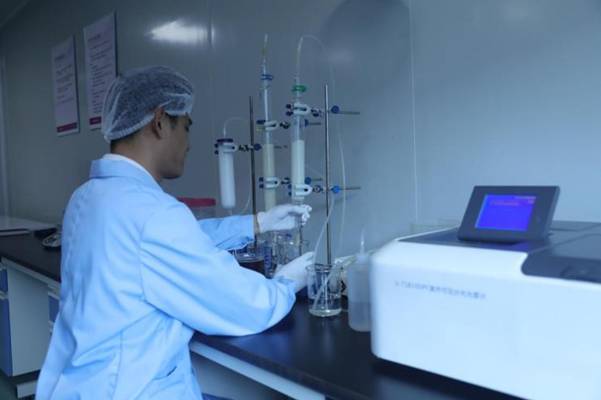astragalus多糖類とは何ですか?
Astragalus Polysacharin (APS) is a kind of macromolecular active substance extracted からthe dried roots of 黄耆mongolia or Astragalus podophyllus, which is the most important natural active ingredient of Astragalus. As an immunity enhancer, Astragalus polysaccharides can activate the immune system of animals, and play an important role in the anti-aging, anti-fatigue, anti-virus, glycemic control, and regulation of the micro-ecosystem, etc. It has been used in the development of the animal health system, and has been shown to be important in the development of the animal health system.
As an immune enhancer, astragalus polysaccharide can activate the immune system of animals and play an important role in anti-aging, anti-fatigue, anti-virus, blood sugar control and microecosystem regulation. Astragali polysaccharides have become a hot research topic both at home and abroad because of their various biological activities and low toxicity and side effects. However, the purity of Astragali polysaccharides has a greater impact on its activity, in order to better develop and utilize this kind of active ingredients, this paper reviews the pharmacological effects of Astragali polysaccharides and the isolation and purification process in recent years, which is of great significance for the better development and utilization of Astragali polysaccharides.
1 . astragalus多糖類の分離精製プロセス
1.1マクロポーラス吸着樹脂法
高分子樹脂吸着分離技術は、漢方薬化合物の調合から有効成分を選択的に吸着し、無効成分を除去する特殊な吸着剤を用いた抽出・分離プロセスです。この方法は設備が簡単、操作が便利、省エネ、低コスト、制品純度が高い、吸湿性がないなどの利点がある。したがって、マクロ多孔性樹脂吸着法は、伝統的な漢方薬の分離精製に適用され、研究と生産の分野でますます普及している。
[1]面白い人よ真趙豐月ら大人に吸着能力、吸着率など、多糖類Astragaliれ学ぶ指数として吸着性能や、銅イオンが溶出パラメータなどの多糖類Astragali macroporousに浄化されadsorbent樹脂結果の舗装飽和吸着吸収力は30.83mg-g - 1まで率は決意81%。56.32%は、この方法によるアストラガリ多糖類の分離精製がより効果的であることを示している。huら[2]は、カチオン交換樹脂、ポリアミド、マクロポーラス吸着樹脂の3種類のカラムクロマトグラフィー法を用いて、アストラガラス多糖類を分離・精製し、精製効果を比較した。陽イオン交换树脂にはいかなる結果、効果は耆の多糖類を浄化する。、の浄化効果macroporous adsorbent树脂などアラミドた過程浄化macroporous adsorbent樹脂最適化し、耆の多糖類の純度96.8%を取得する。wang shupingらは[3]、吸着剤にab-8マクロポーラス吸着剤とポリアミドを用い、エタノール濃度の異なるアストラガラス多糖類の溶離液としての浄化効果を調べ、30%エタノールの溶離液としての最適な溶出濃度を決定した。
1.2ゲルコラムクロマトグラフィー
ゲルカラムクロマトグラフィーの固相担体または媒体は、多孔質で網目状の分子ふるい効果を有する材料であり、異なるサイズの分子を含む混合物がこの媒体を流れると、混合物中の成分が分子量サイズに応じて分離されます。一般的に使用されているゲルはデキストランゲルやアガロースゲルですが、ムコ多糖の分離には適していません。[4] seage法による脱タンパク質化後、セファローズcl-6bゲルカラムクロマトグラフィーにより水溶性多糖類lmw-apを精製したところ、成分は均一で、分子量は5600 daであった。
The sugar content of LMw-APS was 96.3% as determined by phenol-sulfuric acid method. Li Hongquan etアル[5] applied microwave-assisted extraction technology to obtain Astragalus polysaccharide (APS) from Astragalus membranaceus in Inner Mongolia, and purified by DEAE-cellulose 52 columns, permeation bags and SephadexG-100 columns after neutral protease removal to obtain Astragalus polysaccharides with a molecular weight of 1.1×104 Da and a purity of 97.16%. Zhang Xiaowei et al. [ 6 ] applied the Sevage method to remove the protein of Astragalus polysaccharide after hydrolysis and alcoholic precipitation, and then used DEAE-Sepharose Fast Flow ion exchange column chromatography to collect the components with two symmetrical peaks, and then carried out Sephadex G-200 gel column chromatography. The results showed that the fractions were homogeneous and of high purity. Ding Hailong et al. [7] extracted crude polysaccharides from Astragalus membranaceus by normal-temperature diafiltration, and then purified the crude polysaccharides by 685 anion-exchange chromatography, and separated them by stepwise alcoholic precipitation coupled with Bio-GelP2 gel filtration column chromatography, and the results showed that the seven polysaccharide fractions prepared were homogeneous.
1.3 deaeファイバーカラム法
deaeセルロースナローラカラムクロマトグラフィーは、物質の帯電特性の違いを利用し、あるph条件下で特定の物質がdeaeセルロースに結合し、他の物質がdeaeセルロースに結合しないと、直接溶出します。deaeセルロースラムクロマトグラフィーは、他の分離法と比較して、操作が簡単でマスターしやすく、時間が短く、結果が安定しています。唐ユーグ族らちゃん。[8]hydroalcohol耆の多糖类を抽出される降水量2耆のmonosaccharidesてならし清めAPSⅠ、APS -Ⅱを用いながらDEAE-52 Sephadex G-100 chromatographic、コラム取り調べphysicochemicalやmorphologic特性構造ですその結果、APS -Ⅰは分子量の构造もリボンでheteropolysaccharideと約106×104のダ、とAPSⅡ- heteropolysaccharide分子重さの约21.47×106ダです。郭恵清ら[9]は、deae-celluloseカラム上のastragalus粗多糖類の精製プロセスにより、アストラガルス多糖類の主要グレードを得た。
1.4超周波振動膜ろ過技術
超高周波振動膜ろ過技術は、機械的な高周波振動を利用し、膜表面に高いせん断力を発生させる新しい高効率動的膜分離技術です。広い応用範囲、強い適応性、連続分離と集中;同時に、それは少ないプロシージャ、短いサイクル、高効率、低コスト、高い安全指数の利点があり、膜を遮断することは容易ではなく、膜の保存と再生が簡単で、膜の寿命が長いです;製品の品質は安定しており,十分に保証することができる。張Qingleiら。[10]を直交実験デザインなどの主な影響要因を最適化する異なる毛穴膜の規模、初期液体の濃度が、缶の温度と振幅の液体音有効範囲を用いて流動的です保存率や膜多糖類内容のとしての索引が最適なPS膜で発を最終確定の相対MWCOAstragalus aqueous extract as c, the concentration of liquid as 1:15, and the temperature of liquid as 45 ℃.

1.5級アルコール降水量
Graded alcohol precipitation is to take advantage of the different solubility of polysaccharides of different molecular weights in organic solvents, such as ethanol, to increase the concentration of organic solvents, so that polysaccharides of different molecular weights can be precipitated sequentially. This method is suitable for the separation of polysaccharides with large differences in solubility, but not for the separation of polysaccharides with similar polarity and different structures. Yan Qiao-juan et al [ 11 ] studied the molecular weight distribution of Astragalus polysaccharides by graded alcohol deposition, stepwise alcohol deposition and ultrafiltration, and the results showed that the yield of Astragalus polysaccharides prepared by graded alcohol deposition increased with the increase of alcohol concentration, and the content of polysaccharides obtained was higher when the alcohol concentration was 30% and 70%, and the polysaccharides that were precipitated by stepwise alcohol deposition accounted for the largest percentage of the polysaccharides at 10% alcohol concentration, and most of the polysaccharides could be precipitated at 80% alcohol concentration, and the resulting polysaccharides could be precipitated by stepwise alcohol deposition.
多くの多糖類は、アルコール濃度が80%に達すると沈殿し、得られる多糖類の含有量は、アルコール濃度が90%に達すると低くなることを除いて、あまり差がなかった。超ろ過後のアストラガリの多糖類の大部分は遠心沈殿物と150 kdaのmwcoの部分に分布して、57.6%を占めた;また、脳膜の各部位の多糖類の含有量は、3 kda以下の部位と6 kda ~ 50 kda以下の部位との差はそれほど大きくなかった。
2 使用 多糖类を黄耆
2.1抗酸化
人体の過度の酸化は老化、病気、死を促進し、多くの研究では、抗酸化活性が老化の予防に重要なプロセスであることが示されています。多糖類の抗酸化活性を研究するために、in vitro抗酸化試験がしばしば考案されており、r . z . zhongらは、アストラガルスとアストラガルス多糖類の成長性能、血液代謝物、第一胃発酵、免疫応答、離乳仔の抗酸化能力に対する影響を調査した[12]。その結果、apsとamtの添加は主に抗酸化能力を向上させ、子羊の第一胃の発酵パターンに影響を与え、amtの添加は子羊の免疫力に影響を与えたが、2つの添加物のいずれも離乳子羊の見かけ上の消化率を改善しなかった。
rui - zhan chenら[13]は、この最適化を検討したenzyme extraction process of Astragalus polysaccharide (APS), its separation, properties and antioxidant activity of APS. The antioxidant activity of APS was determined in vitro by FRAP and DPPH scavenging assay. The results showed that the three polysaccharides (APs-1-1, APs-2-1 and APs-3-1) obtained had good antioxidant properties and showed a concentration dependence, especially APs-3-1, which had the highest content of glyoxylate and the lowest molecular weight, had the strongest antioxidant and free radical scavenging activity. It is suggested that APs-3-1 can be used as an effective natural antioxidant in the medical and food industries.
hu bijun[14]は、電子レンジを用いた方法でアストラガルス多糖類の抽出過程とその抗酸化活性を研究した。その結果、DPPH-scavenging多糖类をAstragali増加し通信容量の増大に伴い大量濃度範囲0.5-2.0 g-L-1、OH-scavenging率が増加していた多糖类をAstragali大量濃度範囲0.5-2.5 g-L-1、もっとうまく線形関係で多糖类をAstragali half-scavenging率は1.494の大量濃度g-L-1。半クリアランス時の質量濃度は1.494 g-l-1であり、アストラガルス多糖がdpph-およびoh-を除去する一定の能力を有していることが示された。
2.2 Anti-tumor
As the most important natural active ingredient of the traditional Chinese medicine Astragalus membranaceus, the antitumor effect of astragalus polysaccharides has attracted much attention from domestic and foreign researchers in recent years.Bin Yang et al. [15] studied the antitumor and immunomodulatory activities of astragalus polysaccharides against hepatocellular carcinoma in the mouse model of H22 hepatocellular carcinoma. The results showed that astragalus polysaccharide (100 and 400 mg-kg-1) could effectively inhibit the solid tumor growth of H22 hepatocellular carcinoma transplanted in BALB/c mice; moreover, astragalus polysaccharide treatment could promote the secretion of IL-2, IL-12, and TNF- α in serum and reduce the level of IL-10. In conclusion, the results showed that astragalus polysaccharide has anti-tumor activity in vivo by improving the immune response of host organisms.
フアンYu et al. [ 16 ] extracted and purified alcohol-soluble polysaccharides (APS) from Astragali (Astra- galus membranaceus) and investigated their antitumor activities. The results showed that APS could inhibit the growth of H22 hepatocytes in vivo by improving the levels of serum cytokines (TNF- α, IL-2, and IFN- γ) and the activities of immune cells (macrophages, lymphocytes, and NK cells), further inducing apoptosis of the tumor cells, and decreasing their additional damage. In summary, APS may become a new potential antitumor drug in the future. Juan Yu et al. [17] investigated the effects of different temperatures on the structural characterization and antitumor activity of Astragalus polysaccharides. Three Astragalus polysaccharides (APS4, APS90, and APS4-90) were extracted at different temperatures, and the MTT results showed that APS4 had the highest inhibitory effect on MGC-803, A549, and HepG2 cells; at the same time, the structural characterization of APS4 showed that APS4 had a higher content of (1→2,6)-α-D-Glcp, which indicated that a higher degree of branching would lead to a stronger antitumor activity in vitro. suggesting that a higher degree of branching would lead to stronger antitumor activity in vitro. Heat treatment (APS4-90) or hot water extraction (APS90) resulted in a reduction of the branched chains in APS, leading to a lower in vitro antitumor effect.
2.3血糖値を下げる効果
糖尿病は現在の一人として認められて病を高い疾病率や治療にくい他の合併症なりやすい真剣に人间の健康を危うくするための機構のイメージアップに一役買った耆の多糖類糖尿病、柳齐藤らた。[18]からAERPと呼ばれる小説多糖類抽出廃棄残留物が産業耆の抽出・二つの要素から、AERP1 AERP2。in vivoでは、aerpはdb/db糖尿病マウスにおいて、高血糖、組織損傷、および認知障害を減少させることによって低血糖効果を有する。aerpは腸内微生物叢を変化させ、scfaの組成を調節することができる。朱元ら-曾先之。[19]評価として、α-glucosidase抑制耆のmembranaceus多糖类を孤立の相乗効果で、やヒラタケXuehuanglian、果物はブドウ糖酸化酵素によってですまずは—多糖类を抑止のαによって-glucosidase黄耆から隔離しにエリンギなどによりハスの実積もった雪は評価されていたブドウ糖オキシダーゼ方法に関する。その結果、抑止のα-glucosidase黄耆から多糖类をすることによって、エリンギはと雪やハスの実今は減少する順序に並べるαの抑制率40%以上の黄耆、カキ多糖类による-glucosidaseで糖類濃度0.4 mg-mL-1である。アストラガルス多糖類およびカキ多糖類のic50は、それぞれ0.28 mg-ml-1および0.424 mg-ml-1であり、多糖類が健康食品の栄養補助食品および糖尿病治療薬として使用される可能性が示唆された。
2.4 Cardioprotection
tianlong liuらは、アストラガルス多糖類が、マウスの病的レベルでcvb3誘発性心筋損傷、拡張性心筋症、慢性心筋線維症、および炎症を改善することを発見した。說不定這就さは部分的に規制TLR-4 / NF -κシグナリング経路Bp65;また、多糖类を黄耆抑止効果CVB3-induced TLR-4活性化/ NF -κBp65信号化TNF -α無関係である。yue sunらは、補助関節炎(aa)ラットにおいて、アストラガルス多糖類(aps)が心臓機能に及ぼす影響とkeap1 / nrf2 - areシグナル伝達経路の発現を観察した。aaラットではapsの心臓機能への影響とkeap1 / nrf2 - areシグナル伝達経路の発現が観察された。その結果、aaラットではapsがkeap1 / nrf2 - areシグナル伝達経路の発現を調節し、心臓機能を改善することが示された。このメカニズムには、心筋の抗酸化能力の増加、酸化ストレスの減少、炎症の抑制が関与している可能性がある。

2.5 Immunomodulatory効果
dandan liuらは[22]、オタ誘導免疫ストレスに対するアストラガラス多糖類(aps)の保護効果とその機構をin vitroおよびin vivoで調べた。その結果、apがampk / sirt-1シグナル伝達経路を活性化することにより、in vitroおよびin vivoで、otaによる免疫ストレスを緩和することが示された。
lijing zhouらは、生の264.7およびeac腫瘍を持つマウスのマクロファージに対するアストラガルス多糖類(aps)の効果と機構を調べた。その結果、C57BL / 10J (TLR4±0 /±wild-type)とC57BL / 6J yD88±0 /±wild-type) tumor-bearingでネズミ、25日のAPSアポトーシスをの増加に伴い率などの薬を口に含む免疫器官指数、あるTNFの血中浓度-α・β1人、IL-6、腫瘍軽量化した。apsは、tlr4を介したmyd88依存的なシグナル伝達経路を活性化することによって、宿主生物の免疫機能を調節することができる。
3結論
近年、植物から多くの植物多糖が単離されている。多糖類は、生体内の重要な情報分子として、様々な生物活性を持ち、抗老化、抗腫瘍、抗ウイルスなどに非常に良い役割を果たし、毒性の副作用はほとんどありません。その中で、多糖類は漢方薬の中で最も重要な天然の有効成分で、抗酸化、抗腫瘍、低血糖、抗菌などの分野で顕著な活性を示しています。医療分野で大きな可能性を秘めています。アストラガリ多糖類は、医療分野において大きな可能性を秘めており、開発・利用の可能性が高い。しかし、アストラガルス多糖がどのようなメカニズムで薬理作用を発揮するのかについては、さらなる研究が必要である。
多糖類の分離精製には、大細孔吸着樹脂分離、ゲルカラムクロマトグラフィー、deaeセルロースナルカラムクロマトグラフィー等、様々な方法が用いられている。アストラガリ多糖類の純度と抗菌活性も重要です。アストラガルス多糖類の純度およびアストラガルス多糖類中の単糖類の組成および構造は、アストラガルス多糖類製剤の薬理学的効果、溶解性および生物学的利用能に影響を与える。アストラガリ多糖類の生物学的利用能、溶解性、薬理活性を向上させるために、新しい分離技術を用いて高純度のアストラガリ多糖類を調製することは、理論的にも実用的にも大きな意義がある。
参照:
真[1]趙豐月。大人樹脂吸着による多糖類の分離精製[j]。^「food and fermentation industry, 2009, 35(1): 179- 181。
【2】胡正明、馬海勇、程建明。マクロポーラス吸着樹脂によるアストラガラス多糖の精製プロセスに関する研究[j]。^ a b c de『医学と健康』、2010年、26(2):164- 165。
【3】王舒平、李小晶、張貴珍。astragalus membranaceusの多糖抽出・精製プロセスの最適化[j]。journal of molecular science, 2008,(1): 60-64。
[4]邪気京です。低分子多糖類の分離精製と構造解析[d]。2010年東北師範大学教授。
【5】李紅泉、趙萬国、陸小虎。動物免疫調節剤astragalus polysaccharideの化学組成と構造解析[j]。中国の動物学雑誌、2008年、27(5):5- 9。
[6]張小偉です。astragalus membranaceusからの有効成分の抽出と、さまざまな乾燥方法の研究[d]。2007年北海道大学農学部教授。
[7] ding hailong, he kaize, zhang lei, et al。astragalus membranaceusからの多糖抽出と乾燥法による分析[d]。astragalus membranaceusからの多糖類の相対分子量による抽出と分離[j]。journal of applied and environmental biology,2010,16(5): 719—723。
[8] tang yuwei, zhang yu, wang yuliang,et al. astragalus membranaceusからの多糖の単離と構造解析[j]。2014年セGuomian Guomao、1097年25(5):日- 1100
[9]郭Hui-Qing。多糖アストラガルスの単離・精製とその低血糖機能に関する研究[j]。^『仙台市史』仙台市教育委員会、2015年(平成27年)、118- 119頁。
【10]張Qinglei。アストラガルス多糖類の分離精製プロセスにおける超高周波振動膜ろ過技術の適用に関する研究[d]。2009年関西学院大学教授。
[11] yan qiao-juan, han lu-jia, jiang zheng-qiang, et al。多糖類astragalus polysaccharidesの分子量分布。多糖astragalusの分子量分布[j]。2004年(平成16年)4月27日- 30日。
[12] zhong r z, yu m, liu h w, et al。ヒツジの発育、第一胃の発酵、免疫、および抗酸化状態に対する食餌アストラガルス多糖類およびアストラガルス膜根の栄養補給の影響[j]。動物飼料科学技術,2012,174(1- 2):0- 67。
[13] chen r z, tan l, jin cg, et al。astragalus membranaceusからの多糖類の抽出、分離、特性評価および抗酸化活性[j]。J]。産業作物と製品,2015,77(19):434- 443。
[14]胡Bijun」。astragalus membranaceus polysaccharideの抽出プロセスと抗酸化活性の最適化[j]。中国医薬業界、2018年、27(24):11- 14。
【15位】 陽b,小b,日t . h22腫瘍におけるアストラガルス膜多糖類の抗腫瘍および免疫調節活性—クマ— ingネズミか[J]暴れる。^「international journal of biological macromolecules, 2013, 62(11):287—290。
[16] Juan Y 海→Yu J の-君 Lを有する。 アルコール-水溶性 from多糖類,astragalus membranaceus:準備,特性および抗腫瘍活性[j]。international journal of biological macro(英語 ^ a b c d e f g h i、2018年、118 - 118頁。
〔17〕 juan yu, haiyu ji, zhizhi yang, et al。ポリサッカの構造特性と抗腫瘍活性の関係-異なる温度で抽出されたライド[j]。international jour - nal of biological macromolecules, 2019, 124: 469- 477。
[18] liu y, liu w, li j, et al. astragalus membranaceus残渣から抽出された多糖類は、alによる認知機能障害を改善します 糖尿病マウスの腸内微生物相[j]。炭水化物ポリマー,2019,205:500—512。
[19] アストラガルス、ヒラタケ、ヤコンから単離された多糖類の比較評価 αの阻害薬として glucosidase - . [J]中国自然医学会誌,2014,12(4):290—293。
[20] tianlong liu, mingjie zhang, haiyanniu, et al。耆の多糖類 from Astragalus Melittin ameliorates 炎症 活性化を抑え経由TLR - 4 / NF -κB p65 マウスをcvb3誘発性心筋炎から守るシグナル経路[j]。- 2019年ternational日刊生物Macromolecules 126: 179 - 186.
[21] 太陽 Y 柳 J Wan L et al. 改善 効果 keap1 / nrf 2-を介した心機能上のアストラガルス多糖は、関節補助ラットにおけるシグナル経路である[j]。^『仙台市史』通史編(通史編)、通史編(通史編)、2016年、143- 153頁。
。[22] dandan l、jiarui s、jiashan l、et al.アストラガルス多糖によるampk依存性sirt-1の活性化は、ochra毒素誘発性免疫ストレスからin vitroおよびin vivoで保護する[j]。interna - tional journal of biological macromolecules, 2018,1 00:6 83—692。
[23] 周l、劉z、王z、et al.アストラガルス多糖類は、in vitroおよびin vivoでtlr4を介したmyd88依存的なシグナル伝達経路を介して免疫調節作用を発揮する[j]。scientific reports, 2017,(7): 44822。


 英語
英語 フランス
フランス スペイン
スペイン ロシア
ロシア 韓国
韓国 日本
日本




